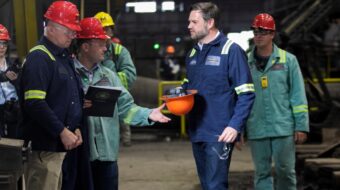
Once again, the nation has witnessed the difference between life and death that comes from having trained, experienced union members on the job.
Combining quick thinking and sheer bravery with their experience as long-time union members, US Airways Flight 1549 pilot Capt. Chesley Sullenberger and co-pilot Jeffrey Skiles, its crew of flight attendants, and the air traffic controllers teamed up to pull off the “Miracle on the Hudson,” in which 155 people survived an emergency landing in New York’s Hudson River on Jan. 15.
The many stories that have appeared in the mainstream media have praised the event as a “miracle” but have failed to point out that every single one of these heroes involved in pulling it off is a union member. Passengers on many commuter airlines, flown by poorly paid non-union pilots and staffed by non-union crews, might not have been as lucky.
All of the airline and airport workers involved in the Jan. 15 miracle were union members who received extensive training that was provided for and required under their union contracts.
Capt. Sullenberger brought the plane and its passengers to a remarkable safe water landing with no engine power. When his passengers and flight crew were safely evacuated from the plane, Sullenberger, according to reports, walked up and down the aisle twice to make sure the plane was empty.
Sullenberger has 40 years of flight experience. During that time he has served as both an instructor and safety committee chairman for the Air Line Pilots Association (ALPA).
Passengers put their heads in their laps and started praying as their plane landed with an enormous splash into the 35-degree waters off Manhattan’s 48th Street. Witnesses on the shore watched in shock as passengers emerged in quick but orderly fashion. It was the three union flight attendants who successfully shepherded them to the temporary safety of the wings and the flotation rescue slides.
The flight attendants are all members of the Airline Flight Attendants-CWA.
“Flight attendants are highly trained safety and security professionals. The successful evacuation was an overwhelming example of the need for union flight attendants on aircraft,” declared Patricia Friend, president of the AFA-CWA. Friend said her union provides flight attendants with extensive training on emergency evacuations, and noted that each year union members undergo additional training to ensure proficiency.
The air traffic controllers who routed the plane around Manhattan, after the pilot reported that a bird strike had shut down both engines, are members of the National Air Traffic Controllers Association.
There are fewer controllers working longer hours these days as a result of the Bush-controlled Federal Aviation Administration’s refusal, for three years now, to bargain a contract with the union.
After the splashdown, passengers huddled on the wings of the plane as waves reached the bottom of the plane’s windows. One commuter ferry, the Thomas Jefferson of the company NY Waterway, arrived within minutes of the crash. The ferry crew and passengers grabbed life vests and lines of rope and tossed them to plane passengers struggling in the freezing water as the plane drifted slowly south.
Soon an armada of police boats, fireboats, tugboats and Coast Guard craft converged on the plane and, eventually, all passengers, including a baby, were safely transferred to the rescue boats.
The ferry crews that responded when they saw the plane in the river are Seafarers (SIU) members. The SIU provides extensive safety training for its members.
The pilots of the ferries that responded are members of the Marine Engineers union.
The police and fireboats that came to pull passengers to safety are operated by members of the Fire Fighters and Patrolmen’s Benevolent Association.
Many of the unions involved, observers note, were the same ones that had performed heroically in New York on 9/11.
jwojcik @pww.org









